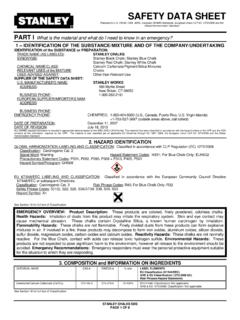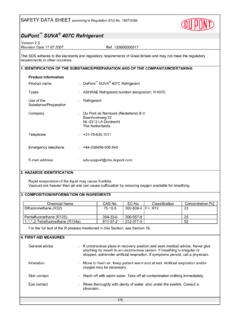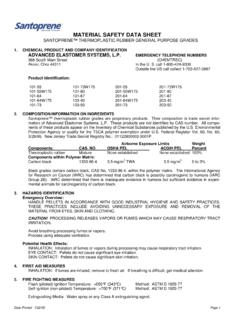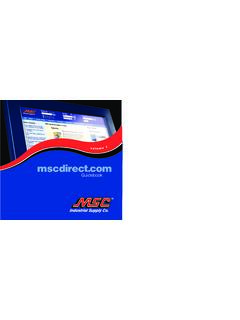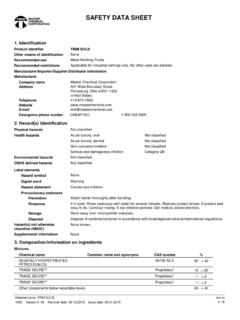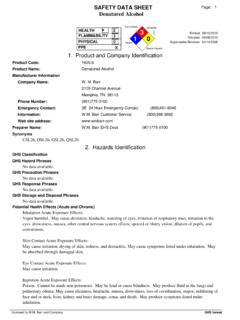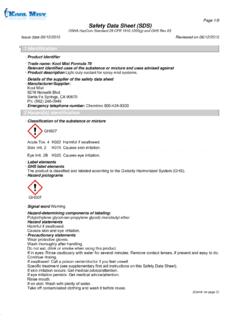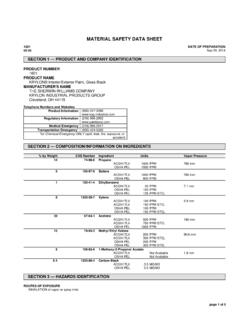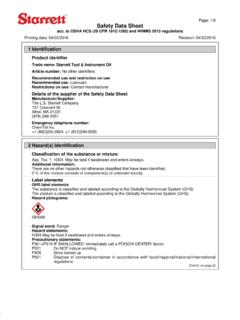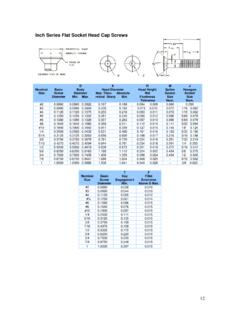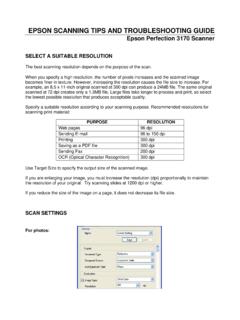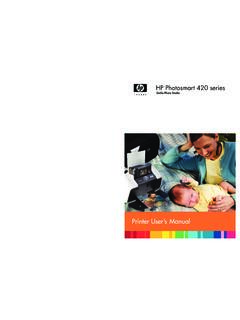Transcription of Material Safety Data Sheet for Printing Ink and Related ...
1 2/10/2009 Page 1 Material Safety data Sheet for Printing Ink and Related Materials: HEALTH HAZARD HMIS Rating Minimal 0 Health [2] Slight 1 Flammability [3] Moderate 2 Reactivity [0] Serious 3 Severe 4 Information supplied on this form is proprietary and is furnished solely for the use of our customer. Date of preparation: January 26, 2009 Prepared by: Don Wright SECTION I PRODUCT/COMPANY IDENTIFICATION Manufacturer s Name: Universal Stenciling & Marking Systems, Inc.
2 Street Address: 205 15th Avenue City, State, Zip: St. Petersburg, FL 33701 Manufacturer Product Class: Printing Ink Product Name: Universal Type D Black Ink Product Code: IU-D14, IU-D1PT, IU-D1QT, IU-D1 QTH, IU-D1GL Emergency Telephone Number: CHEMTREC EMERGENCY CONTACT ONLY 1-800-424-9300 SECTION II COMPOSITION/INFORMATION ON INGREDIENTS CHEMICAL NAME CAS# % EXPOSURE LIMITS IN AIR (ppm) WEIGHT ACGIH OSHA OTHER TLV STEL PEL STEL TWA Ethyl Alcohol 64-17-5 ND ND ND 1900 mg/m3 N- Propyl Alcohol 71-23-8 ND ND ND Ethylene Glycol Monobutyl Ether 111-76-2 ND ND Resin Proprietary NA NA NA NA NA Carbon Black, Amorphous 1333-86-4 NA NA NA NA NA *NA Not Applicable ND Not Determined 2/10/2009 Page 2 Material Safety data Sheet for Printing Ink and Related Materials.
3 SECTION III HAZARD IDENTIFICATION Emergency Overview: Eye: Eye contact with liquid should be prevented through the use of splash goggles. Skin: Skin contact should be prevented through the use of protective clothing. Repeated exposure may cause irritation, even a burn. May cause more severe response on covered skin (under clothing, gloves). Ingestion: All food should be kept in separate areas from those where the ink is stored or used. Eating, drinking or smoking should be prohibited from these areas. Moderate toxicity if swallowed. Small amounts swallowed incidental to normal handling operations are not likely to cause injury; however, swallowing larger amounts may cause injury. Inhalation: If use conditions generate vapor in areas where adequate ventilation is not available, NIOSH approved vapor respirator should be worn.
4 SECTION IV FIRST AID Eyes: Flush eyes thoroughly with copious amounts of water for at least 15 minutes. Consult a physician. Skin: Wash off with soap in flowing water or shower. If symptoms occur, consult a physician. Ingestion: If swallowed, seek medical attention. Do not induce vomiting unless directed to do so by medical personnel. Inhalation: Remove to fresh air if effects occur. Consult a physician if breathing is difficult. Toxicity Information: No specific account of chronic toxicity studies is available. Effects of Overexposure: Eye contact may result in irritation of the eyes. Low order of toxicity on single gross contact. No experimental exposures or repeated doses of long duration have been performed on this product. Note to Physician: No specific antidote. Supportive care. Treatment based on judgment of the physician in response to reactions of the patient.
5 SECTION V FIRE FIGHTING MEASURES Flammable Properties: Flash Point (method) Deg. F. Closed Cup (ASTM D3828-05 Method B) Auto ignition Temperature No data Flammability Limits No data Dust Cloud Ignition Temperature No data Dust Layer Ignition Temperature No data Hazardous Combustion Products: During a fire, smoke may contain the original Material in addition to unidentified toxic and/or irritating compounds. Extinguishing Media: Water fog or fine spray, carbon dioxide, dry chemical or foam. Material Safety data Sheet for 2/10/2009 Page 3 Printing Ink and Related Materials: Fire Fighting Instructions: Keep people away. Isolate fire area and deny unnecessary entry. Burning liquids may be extinguished by dilution with water.
6 Do not use direct water stream. May spread fire. Protective Equipment for Fire Fighters: Wear positive pressure self-contained breathing apparatus (SCBA) and protective fire fighting clothing. If protective equipment is not available or not used, fight fire from a protected location or safe distance. SECTION VI - ACCIDENTAL RELEASE MEASURES Health Precautions: Avoid unnecessary contact and reference the health effects in section III. Spill Procedures: All personnel involved with spill cleanup should follow good industrial hygiene. Wear protective clothing and eye protection to prevent skin and eye contact. Contain spilled Material immediately with an inert substance such as sand, granulated clay or earth. Use plastic or aluminum shovel to transfer waste Material into an appropriate container for disposal. Store in appropriate sealed container for proper disposal. Disposal should be made in accordance with all applicable state, local and federal regulations.
7 SECTION VII HANDLING AND STORAGE Handling: Avoid unnecessary exposure through the use of appropriate controls and good industrial hygiene practices. This product is mildly irritating. Adequate ventilation must be furnished to maintain exposure limits. If working directly from container it must be grounded. Storage: Store closed container in a moderately cool, dry well-ventilated area away from heat and sources of ignition. SECTION VIII EXPOSURE CONTROLS/PERSONAL PROTECTION Engineering Controls: Good general ventilation should be sufficient for most conditions. Local exhaust ventilation may be necessary for some operations. Personal Protective Equipment: Eye/Face Use Safety glasses. Skin Usually not a skin hazard, however use of gloves is helpful in avoiding unnecessary skin contact. Thoroughly wash hands after handling Material and before eating and drinking.
8 Respiratory NIOSH-approved vapor respirator is recommended with handling in areas where adequate ventilation is not available. Exposure Limits: None established. SECTION IX PHYSICAL AND CHEMICAL PROPERTIES Appearance: Black liquid Odor: Alcohol Odor Vapor Density vs Air: Heavier Density: Lbs/Gl Boiling Point: No data Volatile Percent by Weight: VOCS: 2/10/2009 Page 4 Material Safety data Sheet for Printing Ink and Related Materials: SECTION X STABILITY AND REACTIVITY General: Stable under recommended storage conditions. Conditions to Avoid: Heat, sparks, electrical equipment and open flames. Incompatibility With Other Materials: Avoid contact with oxidizing materials. Hazardous Polymerization: No data . Hazardous Decomposition Products: None known. SECTION XI TOXICOLOGICAL INFORMATION Although this product has not been tested, materials contained in the formulation have the following information: PERORAL: Rat; LD50 (470 3000) mg/kg PERCUTANEOUS: Rabbit; LD50 = 220 mg/kg Guinea Pig; LD50 = 2000 mg/kg INHALATION: Vapor study Rat; 7 hours LC50 = 700 ppm Sensitization (Animal And Human Studies) Did not cause allergic skin reactions when tested in humans.
9 Developmental Toxicity - Did not cause birth defects in lab animals. Has been toxic to the fetus in lab animals at doses toxic to the mother. Reproductive Toxicity In animal studies, effects on reproduction have been seen only at doses that produced significant toxicity to the parent animal. Chronic Toxicity and Carcinogenicity In long-term animal studies with ethylene glycol butyl ether, small but statistically significant increases in tumors were observed in mice but not rats. The effects are not believed to be relevant to humans. If the Material is handled in accordance with proper industrial handling, exposures should not pose a carcinogenic risk to man. Genetic Toxicology In Vitro mutagenicity studies were predominantly negative. Animal mutagenicity studies were negative. Significant data With Possible Relevance To Humans - In animals, effects have been reported on the following organs: Blood (hemolysis).
10 Secondary effects to the kidney and liver. Human red blood cells have been shown to be significantly less sensitive to hemolysis than those of rodents and rabbits. SECTION XII ECOLOGICAL INFORMATION Keep out of waterways as this product has not been evaluated for ecotoxicity. 2/10/2009 Page 5 Material Safety data Sheet for Printing Ink and Related Materials: SECTION XIII DISPOSAL CONSIDERATIONS Disposal: DO NOT DUMP INTO ANY SEWERS, ON THE GROUND OR INTO ANY BODY OF WATER. All disposal methods must be in compliance with all Federal, State and Local laws and regulations. Regulations may vary in different locations. Waste characterizations and compliance with applicable laws are the responsibility solely of the waste generator. Unused & Uncontaminated Product: The preferred options include sending to a licensed, permitted: recycler, reclaimer, incinerator or other thermal destruction device.
